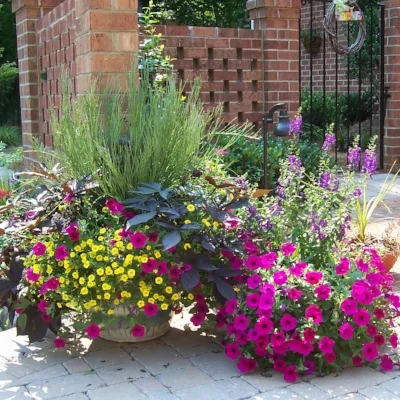Leaf Cutter Bees
So, we've talked about ground nesting bees in the blog before, but there is another type of beneficial bee that you might be seeing signs of in your garden. The evidence looks like this:

The clean-cut half circles excised from the edges of leaves is the calling card of the leaf cutter bee. Redbuds, maples and roses are some of their favorite plants to use in this area. About the same size as a honeybee, they are black and yellow with fuzzy abdomens that they use to carry pollen. Their fuzzy abdomens and their distinctive “swimming” motion when visiting flowers to collect pollen and nectar make them very efficient pollinators. One leaf cutter bee can pollinate as much as 20 honeybees! While leaf cutter bees do have stingers, they are extremely docile and will only sting if handled. Even then their sting is milder than that of a honeybee.
Leaf cutter bee on flower
Leaf cutters are solitary or non-social bees, meaning they do not form hives. Leaf cutter bees use the cut pieces of leaf to line their nests, which are made in soft rotted wood or in the pithy center of plant stems. They do not damage or burrow into intact wood. Nests are divided into a series of cells, each of which contains an egg and a mixture of nectar and pollen which feeds the young once they have hatched. Hatched larvae remain in the nest cells through the winter and emerge in early summer.
While some might find the notches caused by leaf cutters unsightly, they don’t remove enough leaf tissue to cause damage to the plant. It is not necessary to control leaf cutter bees with pesticides due to their being very beneficial as pollinators, their relative harmlessness to humans, and the limited amount of damage they cause. Additionally, insecticides are generally not effective on leaf cutter bees because they do not eat the leaves they cut.
If you’d like to encourage leaf cutter bees to your garden, you can create a welcoming nesting area for them by bundling hollow reeds, bamboo stems (cut at a joint so the reed or stem is closed on one end), or drilling holes in a block of wood to attract leaf cutter bees (and mason bees) to nest. This is a great idea if you have a vegetable garden as their proficiency at pollinating will help ensure a good harvest.

Here are the common ways your landscape is telling you it needs help.
Controlling fall and winter weeds is a constant battle. Here are some of the reasons control can be difficult.
New Garden Landscaping & Nursery feels that Boxwood Blight could have a major impact on landscapes containing boxwood in the near future. Here’s what you need to know about the disease.
Since fall is the time to plant spring blooming bulbs, here are the answers to some common questions about bulbs.
Don't panic, there are a few common (and benign) reasons that trees drop leaves in summer.
Ugh! What’s nastier than a sack of crawly caterpillars hanging from your trees? How about a dozen of ‘em?
Quick tips for avoiding the fungal disease Brown Patch in lawns
Blueberries make great container plants! Watch this video from our friends at Espoma for tips and see how easy it is to grow blueberries in containers.
Good container plantings require little maintenance aside from watering and can enhance your home through the spring, summer, and fall.
Unlike some other flowering plants, crapes will develop their flower buds on new growth.
This is a question we have been asked frequently this fall.
Where and why this is not bad advice, and where it’s a terrible idea.



















